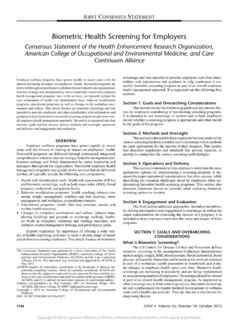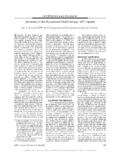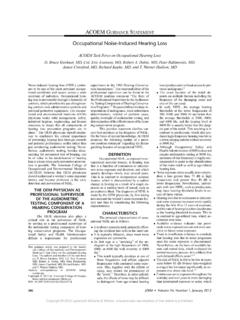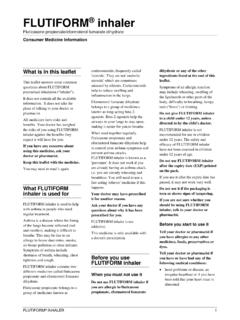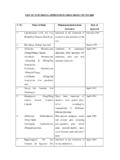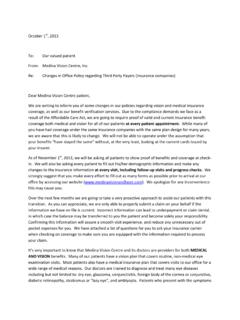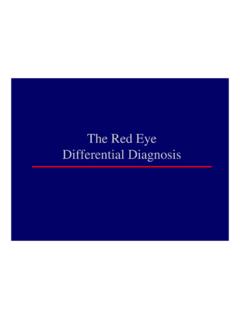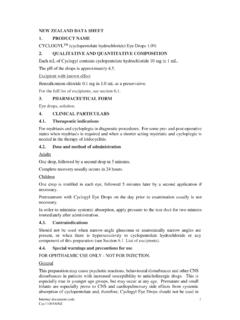Transcription of Vision
1 ACOEM Commercial Driver Medical Examiner Training Course Module 2 Vision , Hearing and Diabetes Pre-read Vision "A person is physically qualified to drive a commercial motor vehicle if that person Has distant visual acuity of at least 20/40 (Snellen) in each eye without corrective lenses or visual acuity separately corrected to 20/40 (Snellen) or better with corrective lenses, distant binocular acuity of at least 20/40 (Snellen) in both eyes with or without corrective lenses, field of Vision of at least 70 in the horizontal meridian in each eye, and the ability to recognize the colors of traffic signals and devices showing standard red, green, and amber.
2 " The required tests measure visual acuity, peripheral horizontal visual fields, and color. Visual acuity is measured in each eye individually and both eyes together. o Distant visual acuity of at least 20/40 (Snellen) in each eye, with or without corrective lenses. o Distant binocular visual acuity of at least 20/40 (Snellen) in both eyes, with or without corrective lenses. Field of Vision of at least 70 in the horizontal meridian in each eye. Color Vision must be sufficient to recognize traffic signals and devices showing the standard red, amber, and green traffic signal colors. When corrective lenses are used to meet Vision qualification requirements, the corrective lenses must be used while driving.
3 A medical examiner, ophthalmologist, or optometrist may perform and certify Vision test results. The medical examiner determines driver certification status. Monocular Vision is disqualifying. Driving and Public Safety - Adequate central and peripheral Vision is necessary for safe driving. The driver must perceive the relative distance of objects, and react appropriately to vehicles in adjacent lanes or reflected in the mirrors, to pass, make lane changes, and avoid other vehicles on the road. The visual demands of driving are magnified by vehicles that have larger blind spots, longer turning radiuses, and increased stopping times.
4 Health History Here are the Vision questions that are asked in the health history. Yes responses require clarification and documentation. Eye disorders? Impaired Vision (do not include corrective lenses)? Here are important Vision questions to ask. Symptoms related to or caused by eye diseases? Use of ophthalmic preparations that have side effects that can affect safe driving? Physical Examination Examine the eyes for: Pupillary equality. Reaction to light and accommodation. Ocular motility. Ocular muscle imbalance. Extraocular movements. Nystagmus. Exophthalmos. Note abnormal findings.
5 Discuss the value of regular Vision examinations in early detection of eye diseases. Ask about: Retinopathy. Cataracts. Aphakia. Glaucoma. Macular degeneration. Medical examiners cannot diagnose these diseases or conditions because most do not have the equipment necessary to diagnose them. Required Tests - Required Vision screening tests include central visual acuity, peripheral Vision , and color Vision . Central visual acuity The Snellen chart or the Titmus Vision Tester measure static central Vision acuity. The requirement for central distant visual acuity is at least 20/40 in each eye and distant binocular visual acuity of at least 20/40.
6 Test results must be recorded in Snellen-comparable values. Eyeglasses or contact lenses may be worn to meet distant visual acuity requirements. When corrective lenses are worn to meet Vision qualification requirements, corrective lenses must be worn while driving. The Snellen chart is widely used for measuring central visual acuity. The Snellen wall chart should be 20 feet away from the driver. o Measure distance. o Mark testing location. The chart should be illuminated with white light. The driver may wear corrective lenses during the examination. When the driver is reading larger lines easily, the medical examiner may ask the driver to skip to smaller lines.
7 The Snellen eye test results use 20 feet as the norm, represented by the numerator in the Snellen test result. The number of the last line of type the driver read accurately is recorded as the denominator in the Snellen test result. The minimum qualification requirement is distant visual acuity of at least 20/40 in each eye and distant binocular acuity of at least 20/40. If a test other than the Snellen is used to test visual acuity, the test results should be recorded in Snellen-equivalent values. There are versions of the Snellen chart that compensate for failure to read letters because of limited English reading skill, not because of poor eyesight.
8 One example is the "Snellen Eye Chart - Illiterate" that requires the individual to indicate the orientation of the letter "E" on the chart. Peripheral Vision - Screening the Visual Field The requirement for peripheral Vision is at least 70 in the horizontal meridian for each eye. In the clinical setting, some form of confrontational testing is often used to evaluate peripheral Vision . When test results are inconclusive, the evaluation should be performed by a specialist with equipment capable of precise measurements. The driver must have at least 70 in the horizontal meridian for each eye. Some form of confrontational testing that tests Vision of selected horizontal points is generally used in the clinical setting.
9 A "Protocol for Screening the Visual Field Using a Confrontation Method" is found in Appendix E of the Visual Requirements and Commercial Drivers report. Right eye examination 1. Stand or sit approximately two feet in front of the driver so that your eyes are at about the same level as the eyes of the driver. 2. Instruct the driver to use the palm of the left hand to cover the left eye. 3. Ask the driver to fixate on your left eye. 4. Extend your arms forward and position your hands halfway between yourself and the driver. Position your right hand one foot to the right of the straight-ahead axis and six inches above the horizontal plane.
10 Position your left hand one-and-a-half feet to the left of the straight-ahead axis and six inches above the horizontal plane. 5. Ask the driver to confirm when a moving finger is detected. Repeat the procedure with your hands positioned six inches below the horizontal meridian. Left eye examination Repeat the procedure for the left eye (steps 2 through 5), making sure the driver fixates on your right eye and the hand placement is appropriately reversed. When test results are inconclusive, obtain specialist evaluation for precise measurement of peripheral Vision . Color Vision The color Vision requirement is met by the ability to recognize and distinguish among red, amber, and green, the standard colors of traffic control signals and devices.

